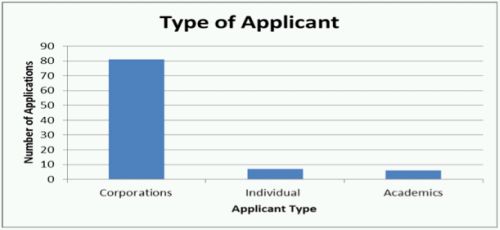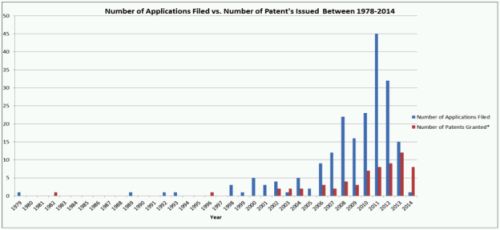INTRODUCTION
In 1979, Dr. Robert Butler and his research team filed a Canadian patent application for the oil recovery technology known as Steam Assisted Gravity Drainage ("SAGD"). Over thirty years later, SAGD technology has become a formative oil-recovery process, with over two hundred patent applications filed in Canada relating to SAGD technology.
SAGD operations have increased primarily due to its potential to enhance bitumen recovery.1 Patent applications have been filed in respect of many aspects of SAGD technology, including the orientation of the wells, the composition of the wells themselves, and the infrastructure that is required to process the bitumen recovered from the producing wells.
This article reviews the growth in patent applications relating to SAGD technology since its inception.
FREQUENCY OF CANADIAN PATENT APPLICATIONS
Though SAGD technology was developed in the late 1970's, the number of Canadian patent applications relating to SAGD technology did not significantly rise in the immediately following decades. However, this last decade has seen a sharp increase in the filings relating to SAGD technology (see Figure 1). This development may be attributable to the expiry of key patents and investments made by companies in SAGD technology as the recovery of bitumen from oil sands became financially more attractive.

Figure 1: Number of Patent Applications Filed from 1978-2014
A search for "steam assisted gravity drainage" in the Patent Database of the Canadian Intellectual Property Office ("CIPO") listed two-hundred and three (203) patents and patent applications related to SAGD technology. These patents and applications can be primarily categorized under the following headings:2
- acceleration of the start-up phase of SAGD;
- energy efficiency;
- bitumen production;
- water recovery and treatment;
- steam production;
- stabilization and mobilization of hydrocarbons; and
- separation of hydrocarbons.
Figure 2 below demonstrates the breakdown of patents and patent applications filed with respect to the above categories.

Figure 2: Number of patent applications and patents for each category of patent.
The majority of patent applicants in Canada over the last thirty years were corporations (see Figure 3). Of these, the largest volume of applications belong to Conocophillips Company, General Electric Company, Imperial Oil Resources Limited, Schlumberger Canada Limited, Suncor Energy Inc., Baker Hughes Incorporated and Nexen Inc.

Figure 3: Types of applicants filing applications from 1979-2014.
It is comparatively rare for patents and patent applications relating to SAGD technology to be owned by individuals. Of the individuals that are listed as owners, roughly half can be considered academics (i.e. they teach on topics related to bitumen recovery and have published related articles), and the other half can be considered non-academics whose connection to SAGD technology may not be readily apparent.
Figure 4 below compares the filing of patent applications with the issuance of patents. As is always the case, significantly more patent applications are filed than are issued as patents (though a greater percentage of patent applications relating to SAGD technology fail to issue as patents).3

Figure 4: Patent applications filed and issued from 1978-2014.
Overall, it appears that the number of patent applications relating to SAGD technology have experienced a sharp rise as corporations have invested and developed the technology in the most recent decade.
Footnotes
1 Marc Humphries, North American Oil Sands: History of Development, Prospects for the Future, online: CRS Report for Congress http://fas.org/sgp/crs/misc/RL34258.pdf.
2 There is a considerable degree of overlap in the applications and patents issued for the above categories.
3 General filing values taken from: Canadian Intellectual Property Office, Annual Report 2012-2013 online: http://www.cipo.ic.gc.ca/eic/site/cipointernet-internetopic.nsf/eng/wr03785.html#patents
To view original article, please click here.
The content of this article is intended to provide a general guide to the subject matter. Specialist advice should be sought about your specific circumstances.


